The iPhone 5s Review
by Anand Lal Shimpi on September 17, 2013 9:01 PM EST- Posted in
- Smartphones
- Apple
- Mobile
- iPhone
- iPhone 5S
Display
The iPhone 5s, like the iPhone 5c, retains the same 4-inch Retina Display that was first introduced with the iPhone 5. The 4-inch 16:9 LCD display features a 1136 x 640 resolution, putting it at the low end for most flagship smartphones these days. It was clear from the get-go that a larger display wouldn’t be in the cards for the iPhone 5s. Apple has stuck to its two generation design cadence since the iPhone 3G/3GS days and it had no indication of breaking that trend now, especially with concerns of the mobile upgrade cycle slowing. Recouping investment costs on platform and industrial design are a very important part of making the business work.

Apple is quick to point out that iOS 7 does attempt to make better use of display real estate, but I can’t shake the feeling of being too cramped on the 5s. I’m not advocating that Apple go the route of some of the insanely large displays, but after using the Moto X for the past month I believe there’s a good optimization point somewhere around 4.6 - 4.7”. I firmly believe that Apple will embrace a larger display and branch the iPhone once more, but that time is just not now.
The 5s’ display remains excellent and well calibrated from the factory. In an unusual turn of events, my iPhone 5c sample came with an even better calibrated display than my 5s sample. It's a tradeoff - the 5c panel I had could go way brighter than the 5s panel, but its black levels were also higher. The contrast ratio ended up being very similar between the devices as a result. I've covered the panel lottery in relation to the MacBook Air, but it's good to remember that the same sort of multi-source components exist in mobile as well.
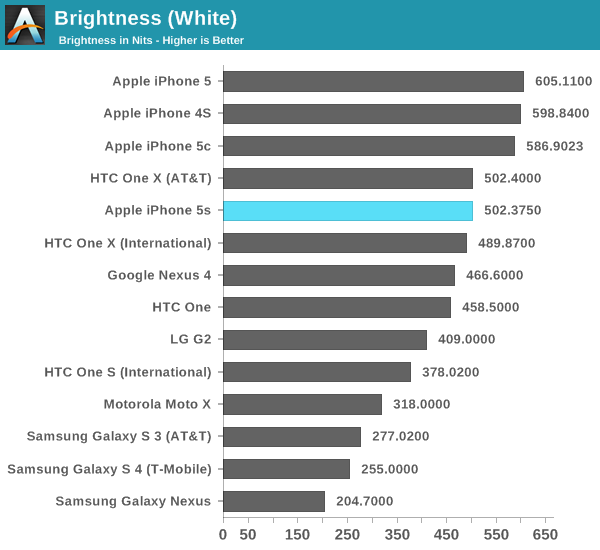
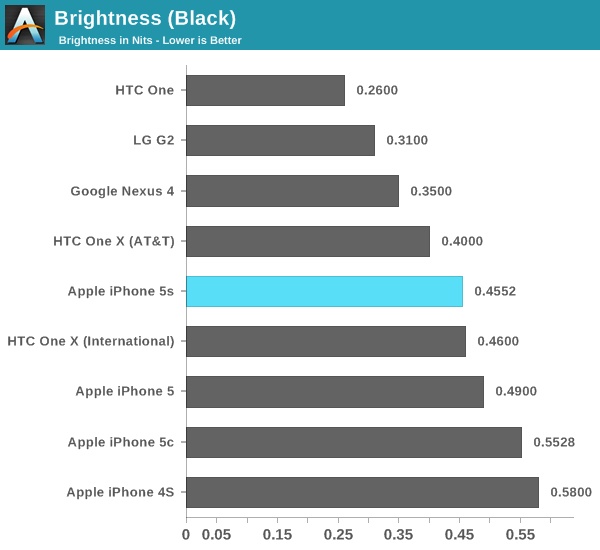
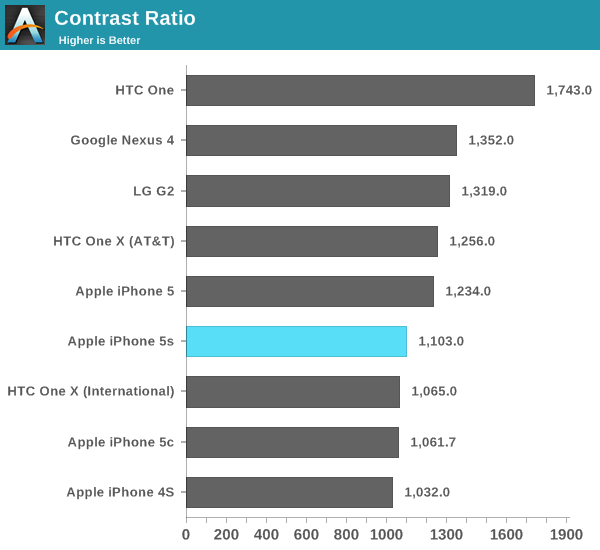
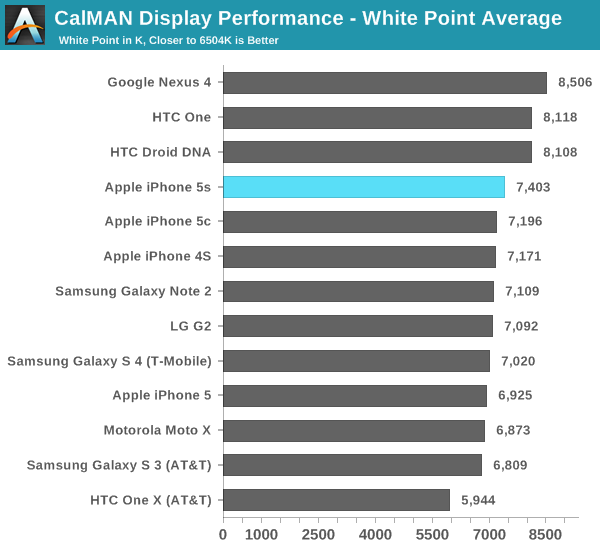

Color accuracy is still excellent just out of the box. Only my iPhone 5c sample did better than the 5s in our color accuracy tests. Grayscale accuracy wasn't as good on my 5s sample however.
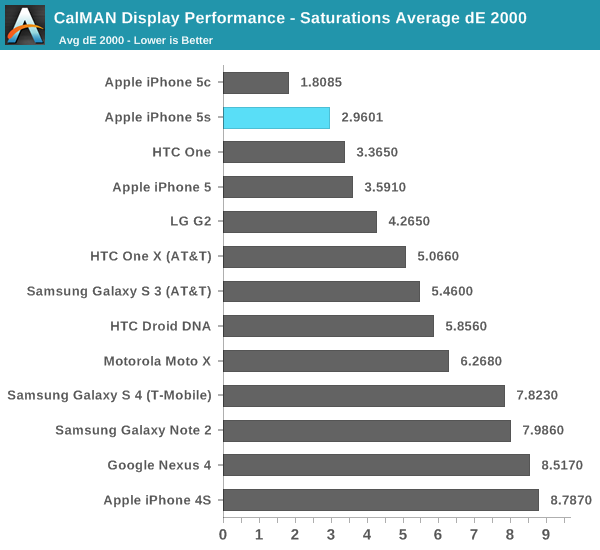
Saturations:

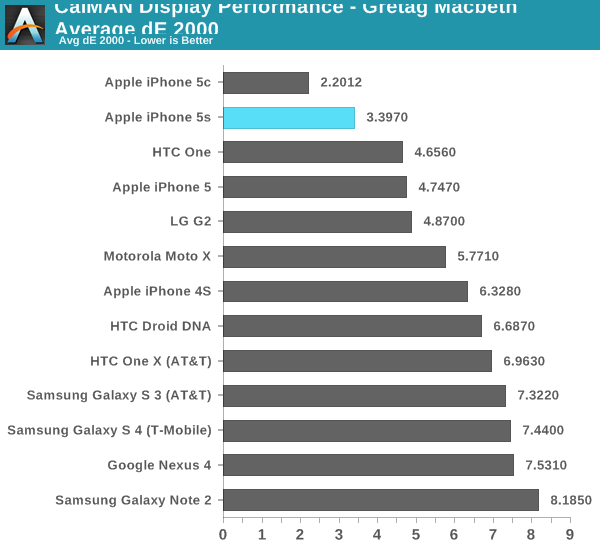
GMB Color Checker:

Cellular
When early PCB shots of the 5s leaked, I remember Brian counting solder pads on the board to figure out if Apple moved to a new Qualcomm baseband solution. Unfortunately his count came out as being the same as the existing MDM9x15 based designs, which ended up what launched. It’s unclear whether or not MDM9x25 was ready in time in order to be integrated into the iPhone 5s design, or if there was some other reason that Apple chose against implementing it here. Regardless of the why, the result is effectively the same cellular capabilities as the iPhone 5.
Apple tells us that the wireless stack in the 5c and 5s is all new, but the lack of LTE-Advanced features like carrier aggregation and Category 4 150Mbps downlink make it likely that we’re looking at a MDM9x15 derivative at best. LTE-A support isn’t an issue at launch, however as Brian mentioned on our mobile show it’s going to quickly become a much needed feature for making efficient use of spectrum and delivering data in the most power efficient way.
The first part is relatively easy to understand. Carrier aggregation gives mobile network operators the ability of combining spectrum across non-contiguous frequency bands to service an area. The resulting increase in spectrum can be used to improve performance and/or support more customers on LTE in areas with limited present day LTE spectrum.
The second part, improving power efficiency, has to do with the same principles of race to sleep that we’ve talked about for years. The faster your network connection, the quicker your modem can transact data and fall back into a lower power sleep state.
The 5s’ omission of LTE-A likely doesn’t have immediate implications, but those who hold onto their devices for a long time will have to deal with the fact that they’re buying at the tail end of a transition to a new group of technologies.
In practice I didn’t notice substantial speed differences between the iPhone 5s, 5c and the original iPhone 5. My testing period was a bit too brief to adequately characterize the device but I didn’t have any complaints. The 5s retains the same antenna configuration as the iPhone 5, complete with receive diversity. As Brian discovered after the launch, the Verizon iPhone 5s doesn’t introduce another transmit chain - so simultaneous voice and LTE still aren’t possible on that device.
Apple is proud of its support for up to 13 LTE bands on some SKUs. Despite the increase in support for LTE bands there are a lot of iPhone 5s SKUs that will be shipped worldwide:
| Apple iPhone 5S and 5C Banding | |||||||
| iPhone Model | GSM / EDGE Bands | WCDMA Bands | FDD-LTE Bands | TDD-LTE Bands | CDMA 1x / EVDO Rev A/B Bands | ||
|
5S- A1533 (GSM) |
850, 900, 1800, 1900 MHz | 850, 900, 1700/2100, 1900, 2100 MHz | 1, 2, 3, 4, 5, 8, 13, 17, 19, 20, 25 | N/A | N/A | ||
|
5S- A1533 (CDMA) |
800, 1700/2100, 1900, 2100 MHz | ||||||
|
5S- A1453 |
1, 2, 3, 4, 5, 8, 13, 17, 18, 19, 20, 25, 26 | ||||||
|
5S- A1457 5C- A1507 |
850, 900, 1900, 2100 MHz | 1, 2, 3, 5, 7, 8, 20 | N/A | ||||
|
5S- A1530 5C- A1529 |
1, 2, 3, 5, 7, 8, 20 | 38, 39, 40 | |||||
| Apple iPhone 5S/5C FCC IDs and Models | |||
| FCC ID | Model | ||
| BCG-E2642A | A1453 (5S) A1533 (5S) | ||
| BCG-E2644A | A1456 (5C) A1532 (5C) | ||
| BCG-E2643A | A1530 (5S) | ||
| BCG-E2643B | A1457 (5S) | ||
| BCG-E2694A | A1529 (5C) | ||
| BCG-E2694B | A1507 (5C) | ||
WiFi
WiFi connectivity also remains unchanged on the iPhone 5s. Dual band (2.4/5GHz) 802.11n (up to 150Mbps) is the best you’ll get out of the 5s. We expected Apple to move to 802.11ac like some of the other flagship devices we’ve seen in the Android camp, but it looks like you’ll have to wait another year for that.
I don’t believe you’re missing out on a lack of 802.11ac support today, but over the life of the iPhone 5s I do expect greater deployment of 802.11ac networks (which can bring either performance or power benefits to a mobile platform).
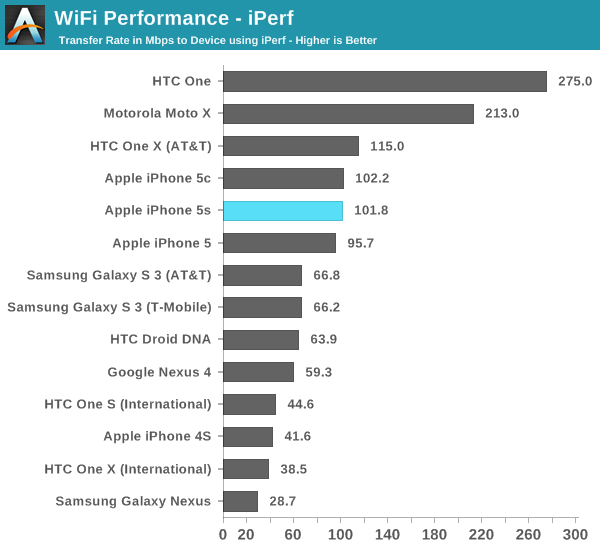
WiFi performance seems pretty comparable to the iPhone 5. The HTC One and Moto X pull ahead here as they both have 802.11ac support.













464 Comments
View All Comments
akdj - Friday, September 27, 2013 - link
I completely agree---that said, we're really only 5 years 'in'. The original iPhone in '07, a true Android follow up in late '07/early '08---those were crap. Not really necessary to 'bench' them. We all kinda knew the performance we could expect, same for the next generation or two. In the past three years---Moore's law has swung in to high gear, these are now---literally---replacement computers (along with tablets) for the majority of the population. They're not using their home desktop anymore for email, Facebook, surfing and recipes. Even gaming---unless their @ 'work' and in front of their 'work Dell' from 2006, they're on their smartphones...for literally everything! In these past three years---and it seems Anand, Brian and crew are quite 'up front' about the lack of mobile testing applications and software----we're in it's infancy. 36 real months in with software, hardware and OS'es worth 'testing, benchmarking, and measuring' their performance. Just my opinion....and I suppose we're saying the same thing.That said---even Google's new Octane test was and is being used lately---GeekBench has revised their software, it's coming is my point. But just looking at those differences in the generations of iPhones makes it blatantly obvious how far we've come in 4/5 short years. In 2008 and 9---these were still phones with easier ways to text and access the internet, some cool apps and ways to take, manipulate and share pics and videos. Today----they do literally everything an actual computer does and I'd bet---in a lot of cases, these phones are as or more powerful, faster and more acessible than those ancient beige boxes from the mid 2000s a lot of folks have in their home office;)
Duck <(' ) - Thursday, October 3, 2013 - link
they are posting false benchmark scores. Same phones score different in youtube vids.iPhone 5 browsermark 2 score is around 2300
check here https://www.youtube.com/watch?v=iATFnXociC4
sgs4 scores 2745 here https://www.youtube.com/watch?v=PdNE4NoFq8U
ddriver - Wednesday, September 18, 2013 - link
Actually, there are quite a lot of discrepancies in this review.For starters, the "CPU performance" page only contains JS benchmarks and not a single native application. And iOS and Android use entirely different JS engines, so this is literally a case of comparing apples to oranges.
Native benchmarks don't compare the new apple chip to "old 32 bit v7 chips" - it only compares the new apple chip to the old ones, and also compares the new chip in 32bit and 64 bit mode. Oddly enough, the geekbench at engadget shows tegra 4 actually being faster.
Then, there is the inclusion of hardware implementation in charts that are supposed to show the benefits of 64bit execution mode, but in reality the encryption workloads are handled in a fundamentally different way in the two modes, in software in 32bit mode and implemented in hardware in 64bit mode. This turns the integer performance chart from a mixed bad into one falsely advertising performance gains attributed to 64bit execution and not to the hardware implementations as it should. The FP chart also shows no miracles, wider SIMD units result in almost 2x the score in few tests, nothing much in the rest.
All in all, I'd say this is a very cleverly compiled review, cunningly deceitful to show the new apple chip in a much better light than it is in reality. No surprises, considering this is AT, it would be more unexpected to see an unbiased review.
I guess we will have to wait a bit more until mass availability for unbiased reviews, considering all those "featured" reviews usually come with careful guidelines by the manufacturer that need to be followed to create an unrealistically good presentation of the product. That is the price you have to pay to get the new goodies first - play by the rules of a greedy and exploitative industry. Corporate "honesty" :)
I don't say the new chip is bad, I just say it is deliberately presented unrealistically good. Krait has expanded the SIMD units to 128 bit as well, so we should see similar performance even without the move to a 64bit ecosystem. Last but not least, 64bit code bloats the memory footprint of applications because of pointers being twice as big, and while those limited memory footprint synthetic benches play well with the single gigabyte of ram on this device, I expect an actual performance demanding real world application will be bottlenecked by the ram capacity. All in all, the decision to go for 64 bit architecture is mostly a PR stunt, surely, 64bit is the future, but in the case of this product, and considering its limited ram capacity, it doesn't really make all that sense, but is something that will no doubt keep up the spirit of apple fanboys, and make up for their declining sales while they bring out the iphone 6, which will close all those deliberately left gaping holes in the 5s.
Slaanesh - Wednesday, September 18, 2013 - link
Interesting comment. I'd like to know what Anand has to say about this.ddriver - Wednesday, September 18, 2013 - link
I am betting my comment will most likely vanish mysteriously. I'd be happy to see my concerns addressed though, but I admit I am putting Anand in a very inconvenient position.Mondozai - Wednesday, September 18, 2013 - link
It's all a conspiracy. In fact your comment has already disappeared, but in its place is now a hologram effect that makes it impossible to tell it from the blank space. So why put in the hologram and not just delete it? Because Anand is playing mind games with us.And who said I typed this comment? It could have been someone else, someone doing Anand's bidding.
I admit I am putting his scheme of deception in a very difficult position right now.
/s
ddriver - Wednesday, September 18, 2013 - link
Few days ago I posted a comment criticizing AT moderators being idle and tolerant of the "I make $$$ sitting in front of my mac" spam, few minutes later my comment was removed while the spam remained, which led me to expect similar fate for this comment. Good thing I was wrong ;)WardenOfBats - Wednesday, September 18, 2013 - link
I'd honestly like to see your misleading comment removed as well. You seem to think that anyone cares what the 32bit performance is of the 5S when everyone knows damn well that app developers are going to be clamouring to switch to the 64bit tech (that Android doesn't even have or support) to get these power increases. Other than that, the rest of your comment is just nonsense. The whole point is that the iPhone 5S is faster and the fact that they use different JS engines is a part of that. Apple just knows how to make software optimizations and hardware that runs them faster and you can see how they just blow the competition away.CyberAngel - Thursday, September 19, 2013 - link
Misleading? Yes! In favor of Apple!You need to double the memory lines, too and caches and...oh boy!
The next Apple CPU will be "corrected" and THEN we'll see...hopefully RAM is 8GB...
Ryan Smith - Thursday, September 19, 2013 - link
As we often have to remind people, we don't delete comments unless they're spam. However when we do so, any child comments become orphaned and lose their place in the hierarchy, becoming posts at the end of the thread. Your comment isn't going anywhere, nor have any of your previous comments.